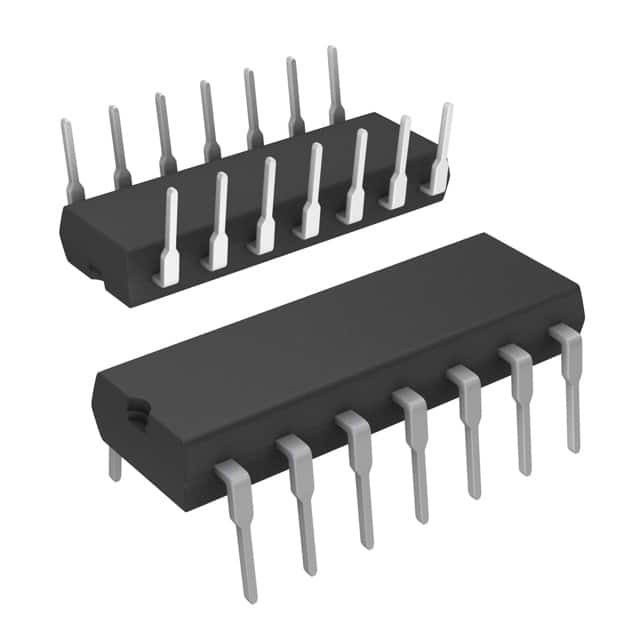Voir les spécifications pour les détails du produit.

Encyclopedia Entry: 74F164APC
Product Overview
Category
The 74F164APC belongs to the category of integrated circuits (ICs), specifically a shift register.
Use
This IC is commonly used in digital electronics for serial-to-parallel data conversion and parallel data storage applications.
Characteristics
- The 74F164APC is a 8-bit serial-in, parallel-out shift register.
- It operates at high-speed, making it suitable for time-critical applications.
- This IC has a wide operating voltage range, typically between 4.5V and 5.5V.
- It offers excellent noise immunity and low power consumption.
- The 74F164APC is designed to be compatible with various logic families.
Package and Quantity
The 74F164APC is available in a standard 14-pin dual in-line package (DIP). It is commonly sold in reels or tubes containing multiple units.
Specifications
- Supply Voltage Range: 4.5V to 5.5V
- Operating Temperature Range: -40°C to +85°C
- Maximum Clock Frequency: 100 MHz
- Input/Output Logic Compatibility: TTL, CMOS
Pin Configuration
The 74F164APC has 14 pins arranged as follows:
+---+--+---+
Q1 |1 +--+ 14| VCC
Q2 |2 13| Q0
Q3 |3 12| SER
Q4 |4 11| GND
Q5 |5 10| CLK
Q6 |6 9| MR
Q7 |7 8| Q7'
+----------+
Functional Features
- Serial Data Input (SER): This pin receives the input data bit by bit.
- Clock Input (CLK): The CLK pin controls the shifting of data through the register.
- Master Reset (MR): When MR is set to a low logic level, it clears the register and sets all outputs to zero.
- Parallel Outputs (Q0-Q7): These pins provide the parallel output of the shifted data.
Advantages and Disadvantages
Advantages
- High-speed operation enables efficient data transfer.
- Wide operating voltage range allows for compatibility with various systems.
- Excellent noise immunity ensures reliable performance.
- Low power consumption contributes to energy efficiency.
Disadvantages
- Limited storage capacity due to its 8-bit design.
- May require additional components for more complex applications.
Working Principles
The 74F164APC operates based on the principle of serial-in, parallel-out shifting. It receives data serially through the SER pin and shifts it through the internal shift register upon each clock pulse received at the CLK pin. The shifted data is then available in parallel form at the Q0-Q7 output pins. The MR pin can be used to reset the register and clear the outputs.
Application Field Plans
The 74F164APC finds application in various fields, including: 1. Data communication systems 2. Industrial automation 3. Consumer electronics 4. Automotive electronics 5. Robotics
Alternative Models
Some alternative models that offer similar functionality to the 74F164APC include: - 74HC164: A CMOS version with compatible pin configuration. - CD4015: A dual 4-bit static shift register. - SN74LS164: A TTL version with comparable specifications.
In conclusion, the 74F164APC is a versatile and widely used integrated circuit that provides efficient serial-to-parallel data conversion and parallel data storage capabilities. Its high-speed operation, wide voltage range, and compatibility with various logic families make it a popular choice in digital electronics applications.
Word count: 470 words
Énumérez 10 questions et réponses courantes liées à l'application de 74F164APC dans les solutions techniques
Sure! Here are 10 common questions and answers related to the application of 74F164APC in technical solutions:
Q: What is the 74F164APC? A: The 74F164APC is a 8-bit serial-in/parallel-out shift register integrated circuit (IC) commonly used in digital electronics.
Q: What is the purpose of a shift register? A: A shift register allows for the sequential shifting of data bits, either in or out, which is useful for tasks like data storage, data transfer, and parallel-to-serial or serial-to-parallel conversion.
Q: How does the 74F164APC work? A: The 74F164APC has a serial input pin (SI) and a clock input pin (CLK). When CLK receives a pulse, the data at SI is shifted into the register. The shifted data can then be read from the parallel output pins (Q0-Q7).
Q: What is the maximum clock frequency supported by the 74F164APC? A: The 74F164APC can typically operate at clock frequencies up to 100 MHz.
Q: Can I daisy-chain multiple 74F164APC ICs together? A: Yes, you can connect the serial output (Q7) of one 74F164APC to the serial input (SI) of another to create a longer shift register chain.
Q: What is the power supply voltage range for the 74F164APC? A: The 74F164APC typically operates with a power supply voltage between 4.5V and 5.5V.
Q: Does the 74F164APC have any built-in output latches? A: No, the 74F164APC does not have built-in output latches. The outputs change immediately with each clock pulse.
Q: Can I use the 74F164APC to drive LEDs or other low-power devices? A: Yes, the outputs of the 74F164APC can be used to drive LEDs or other low-power devices directly, as long as the current requirements are within the IC's specifications.
Q: Are there any special considerations for cascading multiple 74F164APC ICs? A: When cascading multiple ICs, you need to ensure that the CLK signal reaches all the ICs simultaneously to maintain proper synchronization.
Q: Can I use the 74F164APC in both parallel and serial data transfer modes? A: Yes, the 74F164APC supports both parallel and serial data transfer modes, making it versatile for various applications.
Please note that these answers are general and may vary depending on specific datasheets and application requirements.

